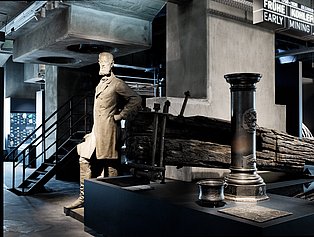
Work and everyday life are the cornerstones that have shaped the lives of at least a large part of the population in the Ruhr area over two centuries. The hard work in heavy industry, underground or at the blast furnace, but also in the numerous subcontracting and processing industries, has shaped people just as much as the living environment dominated through and through by this industry, which determined everything from economic and social conditions to family structure and leisure activities. In this respect, the Ruhr area in the industrial age is a specific way of life that may have had similarities with other societies, but existed in this way only here.
For the Ruhr Museum, the industrial history collection represents something like the core of its identity. For the Ruhr Museum on the Zollverein UNESCO World Heritage Site is of course primarily associated with industrial culture. But this impression is deceptive. The industrial and social history collection has only existed in its present form since the 1980s and owes its existence above all to the structural change that began at that time with the mass accumulation of relics of the industrial age that had become functionless. Nevertheless, since the museum was founded over a hundred years ago, there have been repeated efforts to turn it into an industrial museum. Before the Second World War, there was an important collection of technical history, but little of it has survived.
Today's collection focuses, on the one hand, on the Ruhr's industrial past and, on the other, on the everyday life of people in the industrial age. The collection comprises over 100.000 objects and continues to grow, mainly through personal donations and the acquisition of inventories from private and public institutions. In the process, the collection's development is increasingly opening up to the post-industrial era and the ongoing structural change.
Part of the Industrial History Collection can be seen in the Ruhr Museum's Permanent Exhibition.
Large parts of the Industrial History Collection can now be seen in the Schaudepot as part of a guided tour.